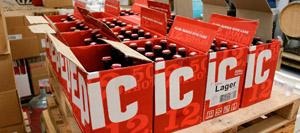
Brewing best practice in supply chain management

By Gareth Berry, Chief Executive Officer, Unleashed Software
Multinational brewing powerhouses – the massive beer and cider brands we all enjoy – rely on elaborate software systems to monitor their production, inventory, sales and the raw materials that they need to produce their famous product. They have complete and detailed insight into their entire supply chain with a few clicks of a mouse. They use: batch tracking to learn when and where ingredients are produced; product monitoring to determine the status of all inbound and outbound deliveries for all warehouses; and analytics tools to predict how much needs to be brewed for seasonal fluctuations in demand. It’s how they compete; comprehensive enterprise resource planning (ERP) systems allow enterprises to differentiate themselves in what is a very competitive market.
But ERP systems are expensive and designed for major operations. So where does that leave small, home-grown craft and microbreweries? Some see ERP as the only real solution, but simultaneously believe their size renders inventory management obsolete – it costs too much and they simply won’t make full use of it – so they continue to work through spreadsheets. Others see the benefit of using software to track and manage their stock, but only use the basic tools found within their existing accounting and bookkeeping suites.
These approaches may suffice in the start-up stages, but a sustainable business model requires a comprehensive and structured approach that creates ongoing value as the business expands. Specialised inventory management software sits at the core of that – it is created specifically for SMBs and provides a collection of resources to support these smaller, product-based operations in addressing two common challenges: product visibility and costing.
Monitoring and understanding exactly how much of any ingredient, label and package is in supply, when it is or will be available and how long it will take to be delivered is critical for microbreweries.
In layman’s terms, product visibility allows brewers to distinguish between what is collecting dust versus what is actually being used. This informs supply chain and production to minimise waste and increase product shipments based on sales trends. It also means brewers can account for expected variations based on previous years’ trends and produce additional batches to cater for summer increases, for example.
Complementary to product visibility is costing, a frequently overlooked and underrated component in the inventory management cycle. While there are a number of costing methodologies for valuing stock, the most important element in any approach is consistency in calculation. Using a consistent formula within an inventory management system introduces a level of automation that mitigates the complexities of manual processes. Inventory management software not only accounts for all ingredients and material – everything from barley to bottle labels – but provides a coherent breakdown of spend and return on each item sold.

As Epic grew, Luke Nicholas adopted specialised inventory management software to manage growth.
By using specialist inventory management software in lieu of manual processes, small brewers can instil a structured and systematic culture that will support growth. Take Auckland’s Epic Brewing Company, for example. Founder Luke Nicholas, a talented brewer with a passion for lager, formerly ran the business out of his own head – it was a one-man operation that relied on Luke’s knowledge and memory for sustainability and growth. It worked in the initial stages, but the small craft brewer’s success scaled beyond guesswork – it became unfeasible to micro-manage a rapidly-expanding customer base, particularly once the company developed strong traction in overseas markets, such as Sweden.
The solution was to implement inventory management designed specifically for SMBs, giving Nicholas and his team the capabilities to support the creation of new beers, manage changes in consumer behaviour and accurately track the cost of goods for all items.
Similarly, Zeffer Cider, which only had the basic inventory functions offered by its accounting system, recognised it needed to be able to track and account for the cost of its stock more effectively. With multiple markets, six different flavours and more than 300 customers, Zeffer opted for a comprehensive inventory management platform to allow its team to manage each aspect of the business through an interface that provided real-time updates.
By replacing manual methods of tracking inventory with a SMB-specific inventory management platform, these organisations, and many like them, have access to better management tools and the right financial data to couple with their beer-making skills. This means craft and microbrewers can account for all materials and costs, accurately price their products, ensure clients’ stock is replenished, and consequently maximise profitability.



